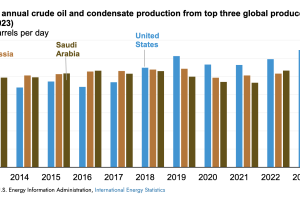China Shake, Bond Jitters, Jobquake

In this buzz: China’s market turbulence sends shockwaves worldwide; The nervousness surrounding the Bond market, and the anticipation in the job market, and a bit more…
Hold onto your calculators
The financial markets are experiencing a rollercoaster ride, with China’s troubles taking the lead. It’s like watching a high-stakes game of economic Jenga, and everyone is on the edge of their seats, waiting for the next move.
Talk about a financial free fall!
As if things weren’t tense enough, U.S. Treasury Secretary Janet Yellen finds herself in the heart of the storm in Beijing, just as trade tensions between the two economic giants escalate.
→ Hong Kong’s Hang Seng index, already down 12% for the year, took a nosedive of over 3% on Thursday, making it the worst day since March.
→ To add fuel to the fire, even the powerful Chinese banks listed in Hong Kong took a beating, plummeting nearly 6% to reach lows not seen in seven months.
💡It’s safe to say they’re having a real rough time, marking their worst two-day performance in nearly 12 years. Somebody fetch a first-aid kit for these banks!
Looks like the domino effect is in full swing.
→ While Shanghai stocks managed to dodge some of the damage with a modest 0.5% drop, Tokyo and Seoul weren’t as lucky.
→ European shares followed suit, slipping over 1% as well.
→ As Wall Street futures flashed a 0.5% decline, the VIX volatility gauge made its grand entrance, surpassing 15 for the first time in over three weeks.
But that’s not all!
The bond markets decided to join the drama, with
→ U.S. and European government bond yields slowly creeping higher.
→ Meanwhile, the Federal Reserve’s latest policy meeting revealed a hesitant governing committee, restating plans for not one but two more interest rate hikes this year.
Talk about a plot twist! Looks like they’re still figuring things out, as New York Fed chief John Williams admitted, “We still have more work to do.” Well, Mr. Williams, we appreciate the honesty!
Speaking of bonds, let’s not forget our friends across the pond.
→British gilts made headlines when an auction of 2-year bonds resulted in the highest yield since 2007. It seems the construction sector sentiment in the UK slid sharply, making matters even gloomier.
Can’t catch a break, can they?
Also…
While the macro picture in Europe is a mixed bag, with ① German industrial orders surging in May but ② euro zone retail sales stagnating, all eyes are now on the mighty U.S. labor markets. Brace yourselves for a series of critical readouts that will likely leave a bigger impact on the Fed’s thinking than any other indicators this week. We’re talking about…
→ ADP’s June take on private sector payrolls,
→ the latest weekly jobless claims numbers, and
→ juicy details of May job openings.
→ Oh, and let’s not forget the grand finale on Friday: the Labor Department’s national employment report.
Will it be a box-office hit or a flop?
Talk about a social media showdown!
→ Meta Platforms (formerly known as Facebook) decided to seize the opportunity and take a swipe at Twitter’s weakened state. With its new feature called Threads, Meta Platforms managed to lure in millions of users in just a matter of hours. Looks like Elon Musk’s decisions have sent some Twitter users running for the hills.
Keep an eye out…
There are some notable events later on Thursday
① the U.S. June ADP private sector jobs report,
② the weekly jobless claims figures,
③ May JOLTS job openings data,
④ the U.S. June ISM service sector business survey, and
⑤ the U.S. May international trade balance.
❗Oh, and don’t forget to tune in to hear what DallasFederal Reserve President Lorrie Logan has to say. Who knows, they might just drop some nuggets of wisdom in the midst of this financial frenzy!
* → Narrowing Goods Trade Deficit: The decrease in the U.S. goods trade deficit indicates that imports fell and exports remained relatively stable. A narrower trade deficit is generally seen as a positive sign for the economy because it suggests that the country is importing less and potentially producing and exporting more. However, the improvement might not be sufficient to significantly boost economic growth.
→ Inventory Investment: The rise in retail inventories indicates that businesses are increasing their stock of goods. This could be interpreted as a sign of optimism, as businesses expect stronger demand in the future. Rising inventories can have a positive impact on economic growth because it indicates increased production and business activity.
→ Trade and Economic Growth: While the narrowing trade deficit is a positive development, it is likely that trade will still act as a drag on economic growth in the second quarter. The ongoing trade imbalances and fluctuations in imports and exports can influence overall economic performance. However, other upbeat economic indicators such as nonfarm payrolls, retail sales, durable goods orders, and housing starts suggest that the economy is maintaining a steady growth path, defying concerns of a recession.
Overall, the data highlights the intricate relationship between trade, inventories, and economic growth. While a narrower trade deficit and rising inventories can be positive factors, their impact on overall economic growth depends on various other factors and the broader economic context.
TRENDING ORIGINALS
Never Miss What’s Happening In Business and Tech
Trusted By 450k+ Readers







